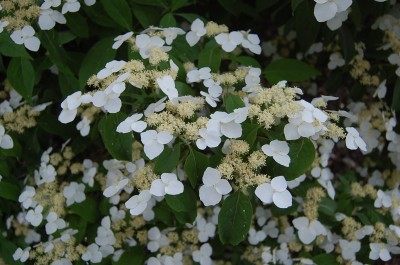Hydrangea umbellata
Since I am one of the new summer interns, I walked around campus the other afternoon to familiarize myself with the various gardens and collections that make up the Scott Arboretum. I made a point to head to the north side of campus where the hydrangea collection is sited. When I left my home state of Tennessee, our bigleaf hydrangea, Hydrangea macrophylla and the more delicate H. serrata were just coming into bloom. Visiting the collection would give me a sense of how far along their Pennsylvanian counterparts were. As I expected, none were in full bloom. However, many were beginning to show swelling flower buds and emerging sepals. Sepals are the showier part of a hydrangea flower.
None were in full bloom, that is, until I rounded the corner and discovered a specimen loaded with white lacecap flowers. At first I wondered, “What cultivar is this?” None of the lacecaps that I was familiar with would be blooming this early. But a glance at the tag showed me that it was, in fact, an entirely different species-the umbel hydrangea (H. umbellata). I took several pictures of it and noted that it was in full bloom on June 5, 2008.
I did some research on it in the Scott Arboretum library and was surprised at the limited amount of published information on it. How such a marvelous shrub has evaded detection I do not know, but good ole Michael Dirr came through for me in his book Hydrangeas for American Gardens. Dirr notes that in full sun he observed H. umbellata fairing much better than a nearby H. macrophylla on a very warm day. He also stated that the umbel hydrangea showed no cold damage while such damage was evident on the bigleaf hydrangea. Unfortunately, I was unable to get over to the collection during the recent heat wave we had; it would have been interesting to see if they had reacted in a similar manner in a more shaded environment.
While the fertile flowers are beginning to fade, the sepals of the umbel hydrangea still look great, and I am eager to see how long this lesser-known species will look presentable. I also suggest you check out the giants of the hydrangea world. The aforementioned H. macrophylla and H. serrata will be in full glory soon; also the ever popular smooth hydrangea (H. arborescens) and oakleaf hydrangea (H. quercifolia) are beginning to strut their stuff. While many oakleaf hydrangeas can be found in the collection, I also suggest you check out the border of them on the east side of Wharton Hall. It is quite impressive to see the variation in the species.








Barbara Shaw
Posted at 11:02h, 17 JuneWelcome Jared, I hope you get as much knowledge and enjoyment as I do when visiting the Scott Arboretum.
Barb
Rhoda Maurer
Posted at 12:21h, 17 JuneJared –
In answer to your question about how the Hydrangea involucrata does at the Scott Arboretum during times of excessive heat… This is an outstanding hydrangea that has done extremely well during times of heat or drought in the Delaware Valley. While it does not have the typical mop-head inflorescence , it has a delicate quality and toughness that make it very garden worthy. I keep hoping that more nurserymen will make this available as I would like to promote it more.